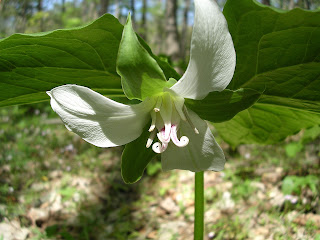In Part 2 of this post I wrote on how to identify the sessile type trilliums. For Part 3, the "nodding" trilliums are going to be discussed. The 'nodding' trilliums belong in the pedicellate group. Pedicellate means that there is a pedicel that connects the flower to the stem unlike the sessile type trilliums whose flowers lack pedicels. The trilliums in the "nodding" group typically have their flowers on long pedicels causing the flower to fall to the side of the plant and often hanging under the leaves. While it is possible for almost any of the pedicellate trilliums to have their flowers "nodding," for the next four species discussed it is typical for the flower to droop.
Photo: Trillium catesbaei, Kestrel360
Trillium catesbaei (Catesby's Trillium, Bashful Wakerobin, Rosy Wakerobin, Trinity Flower, Rosy Trillium)
Trillium catesbaei is normally found in open woods with minimal understory. This plant likes acidic soil and is often found near laurel and rhododendron thickets. In the Mid Atlantic region it is only found in central and western North Carolina. Typically, the plants grow from 12 - 16" tall. The flower color can be white to pinkish. The petals are strongly recurved usually past the sepals. The flower typically droops below the leaves. The only trillium that may cause problems with identification of Trillium catesbaei is Trillium rugelii which grows in the same area. Fortunately, telling the two species apart is not difficult. The easiest way to differentiate between the two species is by the color of the anthers. Trillium catesbaei's anthers are yellow and are strongly recurved. Trillium rugelii's anthers are straight and dark purple.
Photo: Trillium catesbaei, Squamatologist
Trillium cernuum (Nodding Wakerobin, Whip-poor-will Flower)
Photo: Trillium cernuum, Matt MacGillivray
Trillium cernuum is a widespread northern trillium found from northeastern Canada south through Virginia and into the midwest. In the Mid Atlantic region it is found in New York, New Jersey, Pennsylvania, Delaware, Maryland, and Virginia. Typically growing in rich deciduous forest in the southern part of it range, it can also be found in swampy coniferous woodland in the north. The plant can grow from 10 - 20" tall. The white (rarely pink) flower typically droops below the leaves. The petals of the flower are recurved past the sepals.
Drawing: Jim Brighton
Trillium cernuum is very similar to Trillium flexipes. Since the two species do grow together in certain areas they offer a fine identification challenge. The Ohio DNR website says the best way to tell the two species apart is by the length of the flower filaments. In Trillium cernuum the filaments are at least 2/3 as long as the anthers. In Trillium flexipes the filaments are less than half as long as the anthers. Another definitive difference between the two species is the length of the pedicel. The pedicel of Trillium cernuum is only 1.5 to 3 centimeters in length and Trillium flexipes pedicel is 4 to 12 centimeters long.
Photo: Trillium cernuum, Vilma Bharatan
Trillium flexipes (Nodding Wakerobin, White Trillium, Bent Trillium, Declined Trillium)
Photo: Trillium flexipes, Jason Sturner
Trillium flexipes grows in rich forests and floodplains with lots of limestone. Trillium flexipes is mostly a midwestern trillium. In the Mid Atlantic there are scattered populations in New York, Pennsylvania, Maryland, West Virginia, and southwestern Virginia. Typical plants are from 8 - 19" tall. The flower of Trillium flexipes is usually drooping below the leaves but can be held horizontally across the leaves and rarely held upright. The flower should never be facing upwards. The creamy white flower petals are slightly recurved. This plant is very similar to Trillium cernuum. The differences in the two species are noted in the description for Trillium cernuum above.
Photo: Trillium flexipes, Keith Robinson
Trillium rugelii (Southern Nodding Trillium, Ill-scented Wakerobin)
Photo: Trillium rugelii, NC Orchid
In the Mid Atlantic region Trillium rugelii is only found in central and western North Carolina where is grows on forested hillsides and along stream banks and river plains. The plant typically grows to 12" tall. The flower of Trillium rugelii usually droops beneath the leaves. The petals are typically white and are recurved. The straight purple anthers make it easy to tell apart from Trillium catesbaei which has yellow recurved anthers. According to the Flora of North America website, "Trillium rugelii has been much confused with Trillium cernuum in the past and it is the taxon upon which most reports of Trillium cernuum south of Virginia are based."
Trillium vaseyi (Vasey's Trillium, Sweet Beth, Sweet Trillium, Sweet Wakerobin)
Photo: Trillium vaseyi, Squamatologist
Trillium vaseyi grows in the mountains on steep wooded slopes and ravines of the southeast. In the Mid Atlantic region it is only found in North Carolina. The deep red sweet smelling flower of Trillium vaseyi is very large and typically droops below the leaves. Trillium erectum is the only other red flowering trillium that grows in the same area as Trillium vaseyi. The large drooping flower coupled with its sweet odor makes it easy to differentiate between the two species. Trillium erectum has a foul odor. Another difference between the two species is in their bloom times. Trillium vaseyi blooms much later than Trillium erectum which has an early spring bloom. Trillium vaseyi can bloom as late as June. Trillium vaseyi frequently hybridizes with Trillium rugelii. The photo below shows typical flowers of the two species with a hybrid flower in the middle.
Photo: Trillium rugellii (left), Trillium vaseyi (right), hybrid of the two species (center), Jason Hollinger
Photo: Trillium vaseyi, Jason Hollinger
I would like to thank all the photographers who made this post possible
Kestrel360 -- http://www.flickr.com/photos/8343980@N06/
Squamatologist -- http://www.flickr.com/photos/squamatologist/
Matt Macgillivray -- http://www.flickr.com/photos/qmnonic/
Vilma Bhataran -- http://www.flickr.com/photos/16454146@N06/
Jason Sturner -- http://www.flickr.com/photos/50352333@N06/
Keith Robinson -- http://www.flickr.com/photos/kjrob/
NC Orchid -- http://www.flickr.com/photos/ncorchid/
Jason Hollinger -- http://www.flickr.com/photos/7147684@N03/ Jason's flickr site is awesome. Some of the coolest lichen photos on the web.
The regular pedicellate trilliums are up next. Stay tuned!











No comments:
Post a Comment